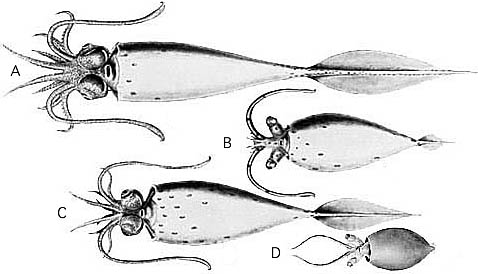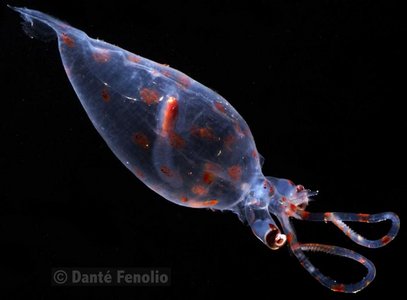Galiteuthis phyllura
Richard E. Young and Katharina M. Mangold (1922-2003)Introduction
This may be the largest species of Galiteuthis if it reaches a length of 2.7 m ML as Nesis (1982) thinks. G. phyllura has been observed repeatedly by underwater vehicles. Hunt (1996) describes a behavior observed by an ROV that may be typical of many cranchiids. When disturbed, this squid hyperinflates the mantle with water and releases ink inside the mantle cavity. It thereby transforms itself from a nearly transparent squid into a very dark one.
Characteristics


Figure. Ventral view of cartilage with tubercules at funnel-mantle fusion, G. phyllura, 173 mm GL. Drawing from Young (1972).
- Photophores
- Lateral (near lens) ocular photophore bar-shaped.
- Lateral (near lens) ocular photophore bar-shaped.
- Tubercules at fused locking apparatuses
- At mantle-funnel fusion: 2-4 small, conical tubercules.
- At mantle-nuchal fusion: none.
Comments
Additional details of the description of G. phyllura can be found here.
Nomenclature
Galiteuthis beringiana (Sasaki, 1920) is a junior synonym of this species (Nesis, 1982).
Life History



Figure. Top - Growth stages of G. phyllura, ventral views. A - 170 mm GL. B - 33 mm GL. C - 79 mm GL. D - 13 mm GL. Note characteristic elongate chromatophores at anterior end of mantle. Drawings of life history stages from Young, 1972. Bottom - Side-oblique view of a young G. phyllura about the size of fig. B to the left. Photograph by Danté Fenolio.
Distribution
Geographical distribution
The type locality is Monterey Bay, California (temperate eastern North Pacific). Its distribution extends from off Baja California to the Bering Sea to off northern Japan (Nesis, 1982).
References
Hunt, J. C. 1996. The behavior and ecology of midwater cephalopods from Monterey Bay: Submersible and laboratory observations. Ph. D. Dissertation, Univ. Calif. Los Angeles. 231 pp.
Young, R. E. 1972. The systematics and areal distribution of pelagic cephalopods from the seas off Southern California. Smithson. Contr. Zool., 97: 1-159.
About This Page
Richard E. Young

University of Hawaii, Honolulu, HI, USA
Katharina M. Mangold (1922-2003)

Laboratoire Arago, Banyuls-Sur-Mer, France
Page copyright © 1999 Richard E. Young and Katharina M. Mangold (1922-2003)
 Page: Tree of Life
Galiteuthis phyllura .
Authored by
Richard E. Young and Katharina M. Mangold (1922-2003).
The TEXT of this page is licensed under the
Creative Commons Attribution-NonCommercial License - Version 3.0. Note that images and other media
featured on this page are each governed by their own license, and they may or may not be available
for reuse. Click on an image or a media link to access the media data window, which provides the
relevant licensing information. For the general terms and conditions of ToL material reuse and
redistribution, please see the Tree of Life Copyright
Policies.
Page: Tree of Life
Galiteuthis phyllura .
Authored by
Richard E. Young and Katharina M. Mangold (1922-2003).
The TEXT of this page is licensed under the
Creative Commons Attribution-NonCommercial License - Version 3.0. Note that images and other media
featured on this page are each governed by their own license, and they may or may not be available
for reuse. Click on an image or a media link to access the media data window, which provides the
relevant licensing information. For the general terms and conditions of ToL material reuse and
redistribution, please see the Tree of Life Copyright
Policies.
Citing this page:
Young, Richard E. and Mangold (1922-2003), Katharina M. 2008. Galiteuthis phyllura . Version 07 January 2008 (under construction). http://tolweb.org/Galiteuthis_phyllura/19574/2008.01.07 in The Tree of Life Web Project, http://tolweb.org/








 Go to quick links
Go to quick search
Go to navigation for this section of the ToL site
Go to detailed links for the ToL site
Go to quick links
Go to quick search
Go to navigation for this section of the ToL site
Go to detailed links for the ToL site